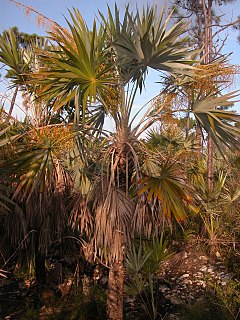
Cordia is a genus of flowering plants in the borage family, Boraginaceae. It contains about 300 species of shrubs and trees, that are found worldwide, mostly in warmer regions. Many of the species are commonly called manjack, while bocote may refer to several Central American species in Spanish. The generic name honours German botanist and pharmacist Valerius Cordus (1515–1544). Like most other Boraginaceae, the majority have trichomes (hairs) on the leaves.
Black sage is a common name for several plants and may refer to:

The St. George Village Botanical Garden is a botanical garden with arboretum located at 127 Estate St. George, Frederiksted, Saint Croix, U.S. Virgin Islands. It is open daily except Christmas; an admission fee is charged.

Varronia rupicola, synonym Cordia rupicola, commonly known as the Puerto Rico manjack, is a critically endangered species of flowering shrub in the borage family, Boraginaceae, that is native to the islands of Puerto Rico and Anegada.

The Antillean fruit-eating bat is one of two leaf-nosed bat species belonging to the genus Brachyphylla. The species occurs in the Caribbean from Puerto Rico to St. Vincent and Barbados. Fossil specimens have also been recorded from New Providence, Bahamas.

Coccothrinax barbadensis is a palm found in the Lesser Antilles. Like other members of the genus Coccothrinax, C. barbadensis is a fan palm. The leaves are widely used to thatch roofs.

Calyptronoma is a genus in the palm family, native to the Greater Antilles. They have pinnately compound leaves with short petioles. The name was coined by August Grisebach who first described the genus in his 1846 Flora of the British West Indian Islands.

Gaussia is a genus in the palm family, native to Mexico, Central America and the Greater Antilles. They are solitary, unarmed, and have pinnately compound leaves. The trees have enlarged bases and prop-roots.

The pearly-eyed thrasher is a bird in the thrasher family Mimidae. It is found on many Caribbean islands, from the Bahamas in the north to the Grenadines in the south, with an isolated population on Bonaire. At least two subspecies can be distinguished genetically: Margarops fuscatus fuscatus which is found between the Greater Antilles and Antigua and Barbuda, M. f. densirostris, occurring from Montserrat and Guadeloupe southwards. Its main habitat is bushes and trees in mountain forests and coffee plantations.

The San Juan Botanical Garden, also known as the Botanical Garden of the University of Puerto Rico, is located in the Caribbean city of San Juan, capital of Puerto Rico. This lush 300-acre (1.2 km2) “urban garden” of native and exotic flora serves as a laboratory for the study, conservation and enrichment of plants, trees, flowers, grasses and many other plants. Seventy-five acres are landscaped and open to the general public as well as researchers.

The bridled quail-dove is a species of bird in the family Columbidae. It is found from Saint Lucia in the Lesser Antilles north and west to Puerto Rico.
The Caribbean bioregion is a biogeographic region that includes the islands of the Caribbean Sea and nearby Atlantic islands, which share a fauna, flora and mycobiota distinct from surrounding bioregions.

Roystonea borinquena, commonly called the Puerto Rico royal palm, is a species of palm which is native to Hispaniola, Puerto Rico and the Virgin Islands.

Quararibea turbinata, also known as the swizzlestick tree, is an aromatic plant native to such Caribbean locales as Antigua, Barbados, Dominica, Grenada, Guadeloupe, Hispaniola, Martinique, Montserrat, Netherlands Antilles, Puerto Rico, St. Kitts and Nevis, St. Lucia, Saint Vincent and the Grenadines and the Virgin Islands. It is generally described as a perennial tree or shrub and its common name comes from its use as a swizzle stick and its association with cocktails such as the Rum Swizzle.

Leucothrinax morrisii, the Key thatch palm, is a small palm which is native to the Greater Antilles, northern Lesser Antilles, The Bahamas and the Florida Keys. Until 2008 it was known as Thrinax morrisii. It was split from the genus Thrinax after phylogenetic studies showed that its inclusion in Thrinax would render that genus paraphyletic. The generic name combines leuco with thrinax.

Sabal causiarum, commonly known as the Puerto Rico palmetto or Puerto Rican hat palm, is a species of palm which is native to Hispaniola, Puerto Rico, and the British Virgin Islands. As its common and scientific names suggest, its leaves are used in the manufacture of "straw" hats.

Varronia curassavica, synonym Cordia curassavica, commonly known as black sage or wild sage, is a species of flowering plant in the borage family, Boraginaceae. It is sometimes called tropical black sage to distinguish it from another unrelated species named black sage, Salvia mellifera. It is native to tropical America but has also been widely introduced to Southeast Asia and the tropical Pacific region, where it is an invasive weed. The specific epithet is a latinised form of Curaçao, an island in the southern Caribbean Sea region and the locality of the type collection.

Cordia lutea, known as yellow cordia or in Spanish muyuyo, is a shrubby plant in the borage family (Boraginaceae), native to the Galápagos Islands, mainland Ecuador, Peru, and the Marquesas Islands in Polynesia. Common in the arid lowlands of the Galápagos, its relatively large yellow flowers make it easy to identify.
Varronia bellonis, commonly known as the serpentine manjack, is a species of flowering plant that was first reported in Susúa Puerto Rico in 1992, where a small group of five individuals was found. This endangered shrub is endemic to Puerto Rico. Unfortunately due to habitat destruction, as of 1997, only 99 known plants remained in the wild, and the population of V. bellonis appeared to be in rapid decline. This discovery has spurred a reintroduction effort in Puerto Rico.















